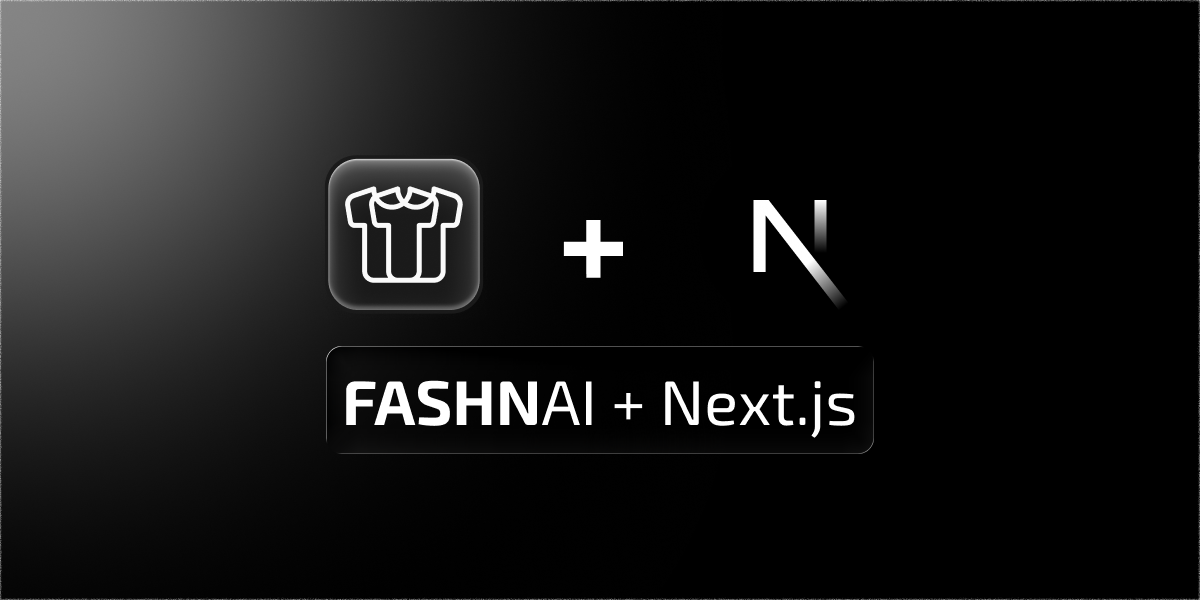FASHNAI
How to Integrate FASHN SDK into Your Next.js Application
Learn how to integrate the FASHN SDK into your Next.js application using Server Actions. This step-by-step tutorial covers project setup, SDK installation, API configuration, and building your first FASHN-powered feature with a practical virtual try-on example.
Written by Renan Ferreira | October 15, 2025

In this guide, you'll learn how to integrate the FASHN SDK into a Next.js application using Server Actions. We'll walk through the complete setup process and demonstrate the integration by building a virtual try-on feature, one of many capabilities the FASHN SDK offers.
What you'll build: A web application with a simple interface that displays a pre-selected model and garment image, then generates a realistic try-on result showing the model wearing that garment.
Tech stack: Next.js App Router, Server Actions, TypeScript, and the FASHN SDK.
By the end of this tutorial, you'll have a solid foundation for integrating FASHN's virtual try-on capabilities into your own projects.
Prerequisites
Before you begin, you'll need a FASHN API key. The SDK uses this key to authenticate all requests to the FASHN API.
Here's how to get your key:
Navigate to the Developer API dashboard and click "Create new API key"
Copy the generated key immediately, you won't be able to view it again after closing the dialog
Store it securely in a password manager or secure note
Important: Your API key should never be exposed to the client side. We'll configure it as a server-side environment variable to keep it secure.
Step 1: Create Your Next.js Project
Let's start by scaffolding a fresh Next.js application. We'll use create-next-app with default settings to get the App Router, TypeScript configuration, and development server set up automatically.
npx create-next-app@latest my-fashn-app --yes
cd my-fashn-app
npm run dev
The --yes flag accepts all defaults, which is perfect for our purposes, it includes TypeScript, ESLint, Tailwind CSS, and the App Router.
Once the server starts, open http://localhost:3000 in your browser. You should see the default Next.js welcome page, confirming everything is working correctly.
Step 2: Install the FASHN SDK
The FASHN TypeScript SDK provides a clean, type-safe interface to the FASHN API. It handles authentication, request/response formatting, automatic polling for generation results, and error handling, eliminating the boilerplate you'd otherwise need to write.
Install it with npm:
npm i fashn
A note on security: The SDK is designed for server-side use only. Always call it from Server Actions, API Routes, or other backend code, never directly from client components. This ensures your API key remains secure.
Step 3: Configure Your API Key
Create a .env.local file in your project root to store your API key:
FASHN_API_KEY=your_api_key_here
Replace your_api_key_here with the actual API key you copied earlier.
Important details:
Don't use the
NEXT_PUBLIC_prefix! That would expose the variable to the browserRestart your development server after creating or modifying environment variables
Add
.env.localto your.gitignoreto prevent accidentally committing secrets
Step 4: Build the User Interface
Now let's create a simple UI that displays the model and garment images and allows users to generate the virtual try-on result. Replace the contents of app/page.tsx with the following:
This interface includes:
Pre-selected images for the model and garment to keep the demo simple
A generate button that triggers the Server Action (which we'll create next)
A results section that displays the generated try-on image
Loading states to provide feedback during generation
Step 5: Create the Server Action
Server Actions let you run secure backend code without setting up separate API routes. Create a new file at app/actions.ts:
This Server Action does the heavy lifting:
Initializes the FASHN client with your API key from the environment
Calls the
subscribemethod, which creates a generation job using thetryon-v1.6model and automatically polls until the result is readyReturns the final image URL to display in your UI
Handles errors gracefully, providing meaningful feedback if something goes wrong
The subscribe method abstracts away the complexity of polling, so you get a simple async function that resolves when the generation is complete.
Step 6: See It in Action
With everything wired up, let's test the application:
Make sure your dev server is still running (
npm run dev)Navigate to http://localhost:3000
You'll see the pre-selected model and garment images displayed
Click "Virtual Try-On"
After a few moments, you'll see the generated result, your model wearing the garment. The FASHN SDK handles the entire process behind the scenes, from job creation to polling to result delivery.
Next Steps
Congratulations! You've built a working virtual try-on application with the FASHN SDK. This demo covers the core integration with pre-selected images for simplicity, but production applications typically need additional features:
User authentication to manage user sessions and limit abuse
File upload to let users provide their own model and garment images
Image validation to ensure inputs meet size and format requirements
Error handling with user-friendly messages and retry logic
Progress indicators to show generation status in real-time
Helpful Resources
Ready to take your integration further? Check out these resources:
- A complete reference implementation with best practices
- Comprehensive API reference and guides
- Detailed SDK documentation and TypeScript types
Happy building! If you create something cool with FASHN, we'd love to see it. Share your project with the community or reach out to our support team.